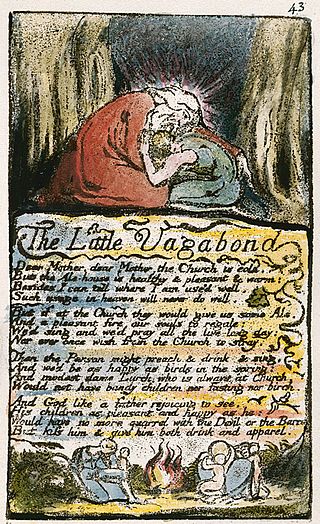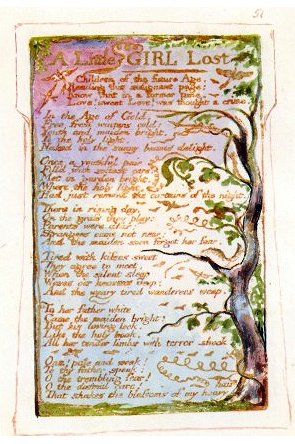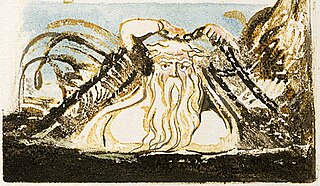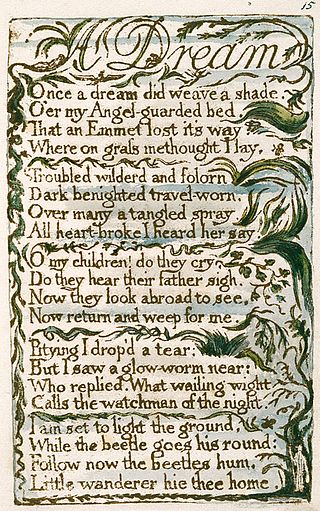
Introduction to the Songs of Experience is a poem written by the English poet William Blake. It was etched and published as part of his collection Songs of Innocence and of Experience in 1794. [1]

Introduction to the Songs of Experience is a poem written by the English poet William Blake. It was etched and published as part of his collection Songs of Innocence and of Experience in 1794. [1]
The poem is etched on a single plate and placed immediately after the title-page of the Songs of Experience. The text has not been found in any draft or manuscript version. Its subject is closely connected with the poem The Voice of the Ancient Bard in the Songs of Innocence . "The Voice of the Ancient Bard" immediately precedes the Introduction to "Songs of Experience" in some copies of the Songs, and Earth's Answer follows in all copies. [2] In the poem, Blake's narratorial voice acts as the Ancient Bard and the Prophet, who hears Jehovah speaking to Adam in the Garden of Eden.
Geoffrey Keynes says that Blake, as the prophet "calls the Fallen Man to regain control of the world, lost when he adopted Reason (the 'starry pole') in place of Imagination.” [3] Earth symbolizes the Fallen Man within the poem. Blake ('the voice of the Bard') calls him to awake from the evil darkness and return to the realm of Imagination, reassuming the light of its previous 'prelapsarian' state. Reason (the 'starry pole') and the Sea of Time and Spece (the 'watr'ry shore') "are there only till the break of day if Earth would consent to leave 'the slumberous mass'". [3]
The illustration shows a big cloud in a night sky and scattered stars. The text is placed on the cloud. There is a nude female with long hair and a halo above her head, reclining on a couch on a cloud below the text. This is probably the image of Earth addressed by "the voice of the Bard".
Coleridge marked the poem with the symbol “H” that meant “still greater” than just “gave me pleasure”. [4] Anonymous Blake's contemporary reviewer (C. A. Tulk? 1830) wrote:
Around these lines the stars are rolling their resplended orbs, and in the cloud on which the song floats, a human form is lying, anxiously surveying their courses: these are a few wild notes struck forth be the hand of a master. [5]
Robert F. Gleckner in his review (1957) notices that Blake hints at the correct reading by means of the ambiguity of the first two stanzas, introducing actually two voices in the poem, the Bard's and the Holy Word's, “calling the lapsed Soul” (line 6).
“The last two stanzas are the words of both voices, perfectly in context when the dual purpose of the poem recognized." [6]
This dual purpose of the poem is to introduce to the state and the songs of experience, “in which the Holy Word of Jehovah is hypocritical, selfish, and jealous, thinking and acting in terms of the physical phenomena of day and night and the earthly morality of rewarding and punishment”, and the same time the Bard being mortal is prophetically imaginative, who “thinks and acts by eternal time and according to eternal values.” [6]
Kathleen Raine in her Blake's Debt to Antiquity (1963) speaks about Blake's idea that “souls who enter the created world from beyond the galaxy become subject to the demiurge”. She says that “Blake reminds the fallen soul that she herself comes from eternity, and ‘might control / The starry pole / And fallen, fallen light renew.’ But in this world she is subject to ‘Starry Jealousy’, who, like the Hermetic demiurge, ‘containing the Circles and Whirling them about, turned round as a Wheel his own Workmanships, and suffered them to be turned from an indefinite Beginning to an undeterminable End’.” [7] Here Raine cited the Divine Poemander attributed to Hermes Trismegistus in the Corpus Hermeticum that looks like a quotation from Blake himself.
The Joshua Tree#20th anniversary remastered edition The list also includes works by: Joseph Charles Holbrooke, UK; Daniel Jenkyn Jones, UK; Kelsey Jones, Canada; Sharon E. Kanach, USA; Joan Anne Littlejohn, UK; Otto Luening, USA; David Lumsdaine, Australia/UK; Frank Mitchell (John Franklin Mitchell), USA; Gordon Myers, USA, Sarah l. Rogers, UK, Sven-David Sandström, Sweden; Paul Schwartz (1907–1999), USA/Austria; Elie Siegmeister, USA; and Leo Smith (1881–1952), Canada. [16]

"The Tyger" is a poem by the English poet William Blake, published in 1794 as part of his Songs of Experience collection and rising to prominence in the romantic period. The poem is one of the most anthologised in the English literary canon, and has been the subject of both literary criticism and many adaptations, including various musical versions. The poem explores and questions Christian religious paradigms prevalent in late 18th century and early 19th century England, discussing God's intention and motivation for creating both the tiger and the Lamb.

"The Lamb" is a poem by William Blake, published in Songs of Innocence in 1789.

"The Chimney Sweeper" is the title of a poem by William Blake, published in two parts in Songs of Innocence in 1789 and Songs of Experience in 1794. The poem "The Chimney Sweeper" is set against the dark background of child labour that was prominent in England in the late 18th and 19th centuries. At the age of four and five, boys were sold to clean chimneys, due to their small size. These children were oppressed and had a diminutive existence that was socially accepted at the time. Children in this field of work were often unfed and poorly clothed. In most cases, these children died from either falling through the chimneys or from lung damage and other horrible diseases from breathing in the soot. In the earlier poem, a young chimney sweeper recounts a dream by one of his fellows, in which an angel rescues the boys from coffins and takes them to a sunny meadow; in the later poem, an apparently adult speaker encounters a child chimney sweeper abandoned in the snow while his parents are at church or possibly even suffered death where church is referring to being with God.

Songs of Innocence and of Experience is a collection of illustrated poems by William Blake. Originally, Blake illuminated and bound Songs of Innocence and Songs of Experience separately. It was only in 1795 that Blake combined the two sets of poems into a volume titled Songs of Innocence and of Experience Shewing the Two Contrary States of the Human Soul. Even after beginning to print the poems together, Blake continued to produce individual volumes for each of the two sets of poetry.

The Book of Thel is a poem by William Blake, dated 1789 and probably composed in the period 1788 to 1790. It is illustrated by his own plates, and compared to his later prophetic books is relatively short and easier to understand. The metre is a fourteen-syllable line. It was preceded by Tiriel, which Blake left in manuscript. A few lines from Tiriel were incorporated into The Book of Thel. Most of the poem is in unrhymed verse.

"London" is a poem by William Blake, published in Songs of Experience in 1794. It is one of the few poems in Songs of Experience that does not have a corresponding poem in Songs of Innocence. Blake lived in London so writes of it as a resident rather than a visitor. The poems reference the "Two Contrary States of the Human Soul". The "Songs of Innocence" section contains poems which reference love, childhood and nature. Critics have suggested that the poems illustrate the effects of modernity on people and nature, through the discussion of dangerous industrial conditions, child labour, prostitution and poverty.

Nurse's Song is the name of two related poems by William Blake, published in Songs of Innocence in 1789 and Songs of Experience in 1794.

Holy Thursday is a poem by William Blake, from his 1789 book of poems Songs of Innocence.

"Holy Thursday" is a poem by William Blake, first published in Songs of Innocence and Experience in 1794. This poem, unlike its companion poem in "Songs of Innocence" (1789), focuses more on society as a whole than on the ceremony held in London.

Earth's Answer is a poem by William Blake within his larger collection called Songs of Innocence and of Experience. It is the response to the previous poem in The Songs of Experience-- Introduction . In the Introduction, the bard asks the Earth to wake up and claim ownership. In this poem, the feminine Earth responds.

The Little Vagabond is a 1794 poem by English poet William Blake in his collection Songs of Innocence and of Experience. His collection, Songs of Innocence, was originally published alone, in 1789. The scholar Robert Gleckner says that the poem is a form of transformation of the boy in the poem "The School Boy", from Songs of Innocence.

"A Poison Tree" is a poem written by William Blake, published in 1794 as part of his Songs of Experience collection. It describes the narrator's repressed feelings of anger towards an individual, emotions which eventually lead to murder. The poem explores themes of indignation, revenge, and more generally the fallen state of mankind.

"Infant Joy" is a poem written by the English poet William Blake. It was first published as part of his collection Songs of Innocence in 1789 and is the counterpart to "Infant Sorrow", which was published at a later date in Songs of Experience in 1794.

"The Shepherd" is a poem from William Blake's Songs of Innocence (1789). This collection of songs was published individually four times before it was combined with the Songs of Experience for 12 editions which created the joint collection Songs of Innocence and of Experience (1794). Blake produced all of the illuminated printings himself beginning in 1789. Each publication of the songs has the plates in a different order, and sixteen other plates were published posthumously.

"A Little Girl Lost" is a poem written by the English poet William Blake. It was first published as part of his collection Songs of Innocence and of Experience in 1794. The poem is written as a clear authorial commentary from Blake, focusing on the tension between human passions and societal expectations.
"The Fly" is a poem written by the English poet William Blake. It was published as part of his collection Songs of Experience in 1794.

"The Human Abstract" is a poem written by the English poet William Blake. It was published as part of his collection Songs of Experience in 1794. The poem was originally drafted in Blake's notebook and was later revised for as part of publication in Songs of Experience. Critics of the poem have noted it as demonstrative of Blake's metaphysical poetry and its emphasis on the tension between the human and the divine.

The Voice of the Ancient Bard is a poem written by the English poet William Blake. It was published as part of his collection Songs of Innocence in 1789, but later moved to Songs of Experience, the second part of the larger collection Songs of Innocence and of Experience, 1794.

"A Dream" is a poem by English poet William Blake. The poem was first published in 1789 as part of Blake's collection of poems entitled Songs of Innocence.

Songs of Innocence and Experience is an album by American beat poet and writer Allen Ginsberg, recorded in 1969. For the recording, Ginsberg sang pieces from 18th-century English poet William Blake's illustrated poetry collection of the same name and set them to a folk-based instrumental idiom, featuring simple melodies and accompaniment performed with a host of jazz musicians. Among the album's contributors were trumpeter Don Cherry, arranger/pianist Bob Dorough, multi-instrumentalist Jon Sholle, drummer Elvin Jones, and Peter Orlovsky – Ginsberg's life-partner and fellow poet – who contributed vocals and helped produce the recording with British underground writer Barry Miles.